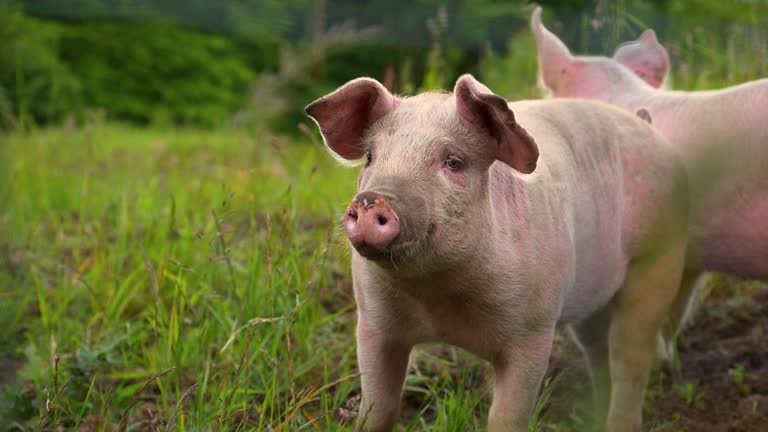The National Veterinary Research Institute in Poland has recently documented the first molecular detection of Sarcocystis miescheriana in a condemned pig carcass in Poland. This research marks a significant milestone, as it represents only the fourth known instance of macroscopically visible cystic lesions caused by sarcocystosis in domestic pigs worldwide. The findings highlight the challenges posed by this protozoan parasite, its impact on food safety, and the need for continued monitoring in meat production.
Sarcocystis miescheriana is a parasitic organism with a prey-predator life cycle. In this cycle, domestic and wild pigs act as intermediate hosts, becoming infected when they inadvertently consume infective oocysts or sporocysts shed by definitive hosts, such as canids. For humans, meat from pigs infected with sarcocystosis poses a concern, as food safety standards deem it unfit for consumption once cystic lesions are visible. While infections in pigs are not typically fatal, they can affect the quality and value of meat products. However, the broader implications of sarcocystosis on livestock production and public health remain underexplored due to the rarity of reported cases.
The recently published study, titled First Molecular Characterization of Sarcocystis miescheriana in a Pig Carcass Condemned During Routine Meat Inspection in Poland, appeared in the Journal of Veterinary Research. It chronicles the detection of visible cystic lesions due to sarcocystosis in a domestic pig during a routine inspection. This case offers a rare opportunity to delve deeper into an often-overlooked parasitic disease.
The study’s researchers described the visible signs as whitish, rice-grain-like lesions embedded in the pig’s muscle tissues. Despite the lesions being macroscopically evident, the pig displayed no symptoms of parasitic infection during its life. This asymptomatic nature further complicates the identification and management of sarcocystosis within livestock populations. Investigators collected tissue samples for gross examination, histological analysis, and molecular testing using polymerase chain reaction (PCR).
Upon histological examination, the team identified a necrotic core surrounded by connective tissue fibers and inflammatory infiltrates in the lesions. Unfortunately, freezing temperatures during sample storage compromised the observation of the characteristic cyst walls. Despite this limitation, molecular testing confirmed the presence of Sarcocystis miescheriana DNA in all ten lesions collected. Notably, these lesions measured up to 1.2 centimeters in length and approximately 3 millimeters in width.
Phylogenetic analysis compared the DNA from the Polish sample with that of other isolates reported globally. The findings placed the Polish isolates in close relationship to samples from pigs and wild boars in Italy and Latvia, suggesting potential regional transmission pathways or common sources of contamination.
As for the origin of this particular infection, the research team could not pinpoint a definitive source. They speculated that the parasite could have entered the pig’s environment through straw used as bedding material, which may have been contaminated with feces from canids or other typical hosts of Sarcocystis miescheriana. This hypothesis aligns with the prevalence of deep bedding systems in the area where the infected pig was raised. However, no direct investigation was conducted at the site, leaving this theory unconfirmed.
One of the study’s notable findings is the difficulty in detecting sarcocystosis during routine meat inspections. Sarcocysts are typically microscopic, making them invisible during standard visual checks of carcasses. This particular case was only identified because the cysts had reached a size visible to the naked eye, a rare occurrence. Given that reported cases of visible sarcocystosis remain scarce, the study raises the possibility that the true prevalence of the parasite in pig populations may be underestimated. Previous cases documented in other countries also suggest that the issue might be more widespread than currently recognized.
The researchers posit that the recent rise in reported cases of sarcocystosis in domestic pigs may not reflect an actual increase in infections but rather a heightened awareness among veterinary inspectors. Improved diagnostic capabilities, coupled with more vigilant surveillance, likely contribute to the identification of cases that previously went unnoticed.
The implications of Sarcocystis miescheriana infections extend beyond food safety concerns. While the parasite does not typically cause severe harm to the infected animal, its presence can lead to economic losses for farmers and meat producers due to the condemnation of affected carcasses. These losses, combined with the potential risks to human health, underscore the need for ongoing research into the prevalence, transmission, and control of sarcocystosis in livestock.
The study concludes by emphasizing the importance of further investigation into the prevalence of Sarcocystis miescheriana and related species in meat-producing animals. Expanding our understanding of this parasite’s lifecycle, host interactions, and environmental reservoirs is critical for developing effective prevention and management strategies. Enhanced surveillance, combined with advances in molecular diagnostic tools, will be essential for addressing the challenges posed by sarcocystosis in livestock production.
Reference: Weronika Korpysa-Dzirba et al, First molecular characterisation of Sarcocystis miescheriana in a pig carcass condemned during routine meat inspection in Poland, Journal of Veterinary Research (2024). DOI: 10.2478/jvetres-2024-0067






